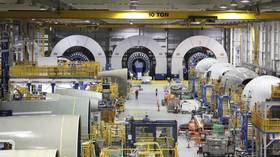Goldman Sachs predicts when India will overtake US in economic rankings

India will surpass the US to become the world’s second-largest economy by 2075, Goldman Sachs has predicted, citing capital investment and favorable demographics. The country is currently the world’s fifth-largest economy, behind the US, China, Japan and Germany.
In an article published last week, the investment bank’s India economist, Santanu Sengupta, projected that the country’s GDP would reach $52.5 trillion, trailing only China at $57 trillion.
On top of a burgeoning population, India’s growth is expected to be driven by progress in innovation and technology, higher capital investment, and rising worker productivity, according to the Goldman Sachs report.
Demohraphics will also be key. “Over the next two decades, the dependency ratio of India will be one of the lowest among regional economies,” Sengupta said.
A country’s dependency ratio is measured by the number of dependents against the total working-age population. Sengupta claims that India has the “best ratio” of working-age population to the number of young and elderly.
Realizing the potential of India’s growing population depends on boosting the participation of its labor force, Sengupta said. He identified a two-decade demographic opportunity forecast that New Delhi should exploit.
“So that really is the window for India to get it right in terms of setting up manufacturing capacity, continuing to grow services, and continuing the growth of infrastructure,” he added.
Increasing labor productivity will translate into greater output for the economy, especially since the country’s government has placed a priority on infrastructure development with roads and railway construction.
Technology and innovation are also seen as major drivers of the Indian economy, the investment bank noted.
India’s technology industry revenue is expected to grow by $245 billion by the end of 2023 supported by IT, business process management and software product streams, Nasscom, India’s nongovernmental trade association, said in a recent report.
Capital investment will become another significant contributor to India’s growth, according to Goldman Sachs.
“India’s savings rate is likely to increase with falling dependency ratios, rising incomes, and deeper financial sector development, which is likely to make the pool of capital available to drive further investment,” the report stated.
For more stories on economy & finance visit RT's business section













